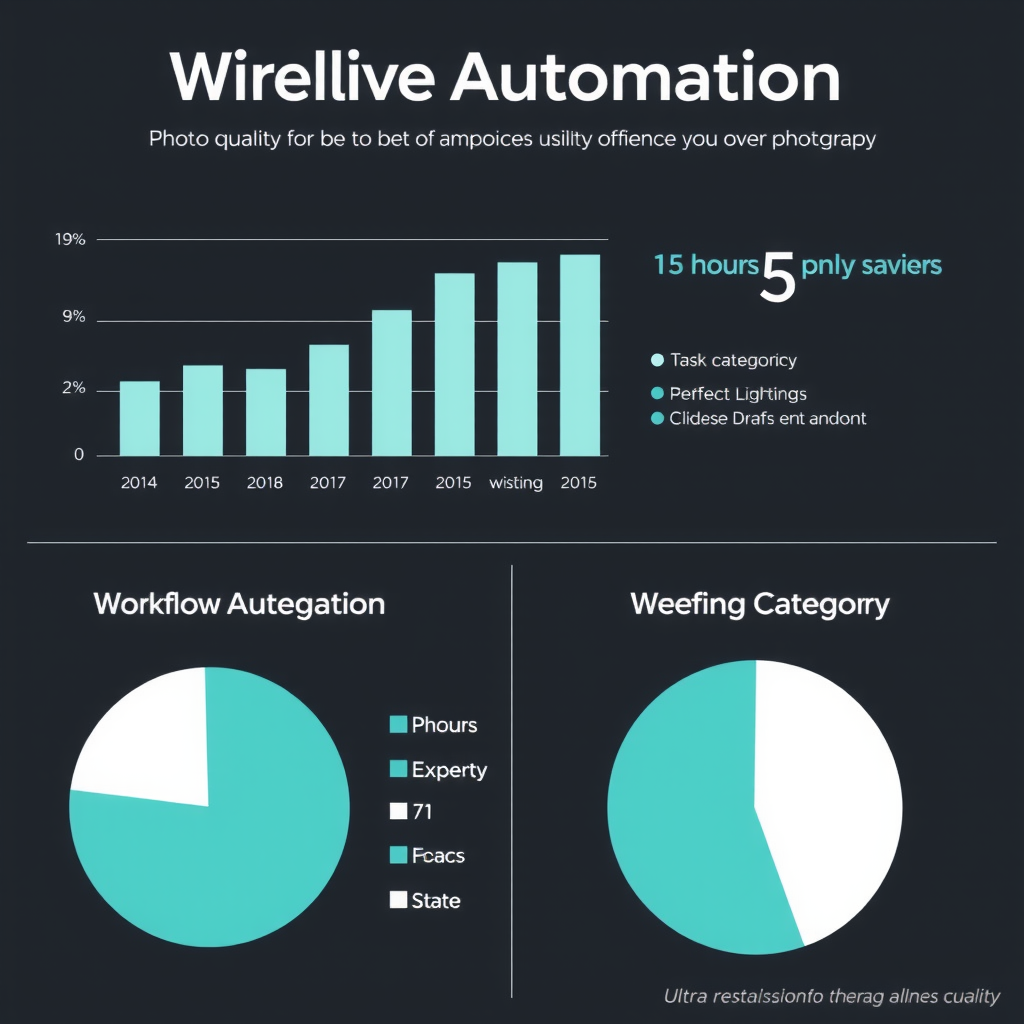Study Shows Freelancers Save 15 Hours Weekly with Workflow Automation

New research conducted in partnership with RemoteFlow Systems reveals that freelancers using comprehensive workflow automation tools save an average of 15 hours per week on administrative tasks. The study surveyed 2,500 independent professionals across design, development, writing, and consulting sectors, highlighting the growing importance of automation in the gig economy.
Key Findings from the Research
The comprehensive study, conducted over six months from April to September 2024, examined the daily workflows of freelancers before and after implementing automation solutions. The results demonstrate significant improvements in productivity and work-life balance across all surveyed sectors.
Time Savings Breakdown
- Client communication and follow-ups 4.5 hours/week
- Invoice generation and payment tracking 3.2 hours/week
- Project scheduling and deadline management 2.8 hours/week
- File organization and document management 2.3 hours/week
- Contract creation and client onboarding 2.2 hours/week
Dr. Sarah Mitchell, lead researcher on the project and professor of digital economics at Stanford University, notes: "The data clearly shows that freelancers who embrace workflow automation not only save time but also report higher job satisfaction and reduced stress levels. The ability to focus on core creative and strategic work rather than administrative tasks is transforming the freelance landscape."

Impact Across Different Freelance Sectors
The study revealed varying levels of time savings across different professional sectors, with some industries benefiting more significantly from automation than others.
Design and Creative Services
Freelance designers reported an average of 16.5 hours saved per week, the highest among all surveyed groups. Automation of client feedback loops, revision tracking, and asset delivery systems proved particularly valuable. Many designers noted that automated project status updates eliminated the need for constant check-in emails with clients, allowing them to maintain creative flow without interruption.
Jessica Torres, a freelance graphic designer from Austin, Texas, shared her experience: "Before implementing workflow automation, I spent nearly 20 hours a week just managing client communications and file deliveries. Now, my clients receive automatic updates at key project milestones, and I can focus on what I do best—creating exceptional designs. It's been a game-changer for my business."
Software Development and Technical Consulting
Developers and technical consultants saved an average of 14.8 hours weekly, primarily through automated code deployment, testing workflows, and client reporting systems. The integration of project management tools with development environments proved especially beneficial, reducing context switching and manual status updates.
Marcus Chen, a full-stack developer specializing in web applications, explained: "Automated testing and deployment pipelines have revolutionized how I work with clients. What used to take hours of manual work now happens automatically, and clients receive detailed progress reports without me lifting a finger. I can take on more projects while maintaining higher quality standards."

Content Writing and Editorial Services
Freelance writers and editors reported 13.2 hours of weekly time savings. Automated content calendars, deadline reminders, and streamlined revision processes contributed most significantly to these gains. Many writers noted that automated invoice generation and payment tracking eliminated one of their least favorite aspects of freelancing.
Business Consulting and Strategy
Consultants experienced an average of 15.7 hours in weekly time savings, with automated client onboarding, proposal generation, and meeting scheduling proving most valuable. The ability to create templated consultation frameworks that could be customized for each client significantly reduced preparation time while maintaining personalization.
Financial Impact and Business Growth
Beyond time savings, the study examined the financial implications of workflow automation for freelancers. The results demonstrate substantial economic benefits that extend well beyond simple efficiency gains.
Average Financial Improvements
The study found that 78% of freelancers who implemented comprehensive workflow automation were able to take on additional clients within three months, with the average freelancer increasing their client roster by 2.3 times. This expansion was achieved without sacrificing quality or increasing work hours, as the time saved on administrative tasks could be redirected toward billable work.
Furthermore, 64% of surveyed freelancers reported being able to raise their rates after implementing automation, citing improved service delivery, faster turnaround times, and more professional client experiences as justification for premium pricing.
Quality of Life Improvements
Perhaps most significantly, the research documented substantial improvements in freelancers' work-life balance and overall well-being. The time saved through automation translated directly into better quality of life metrics across multiple dimensions.

Survey participants reported:
- Reduced stress levels: 82% of freelancers reported feeling less stressed about administrative tasks and deadline management
- Better work-life boundaries: 76% found it easier to disconnect from work during personal time
- Improved sleep quality: 68% reported better sleep patterns due to reduced anxiety about forgotten tasks
- More time for professional development: 71% used saved time to learn new skills or expand their service offerings
- Enhanced client relationships: 89% noted improved client satisfaction due to more consistent communication and faster response times
Rachel Anderson, a freelance marketing consultant from Seattle, shared: "The mental load of remembering to follow up with clients, send invoices, and track deadlines was exhausting. Now that these tasks are automated, I feel like I have my brain back. I'm more creative, more present with my family, and ironically, more productive than ever."
Implementation Challenges and Solutions
While the benefits of workflow automation are clear, the study also examined the challenges freelancers faced during implementation and how they overcame them.
Initial Time Investment
The most commonly cited challenge was the initial time required to set up automation systems. On average, freelancers spent 12-15 hours configuring their workflows, creating templates, and integrating various tools. However, 94% of respondents stated that this investment paid for itself within the first month of use.
Learning Curve
Approximately 43% of freelancers initially felt overwhelmed by the features and possibilities of comprehensive workflow automation tools. Those who succeeded typically started with automating one or two key processes before gradually expanding their automation ecosystem.
The study found that freelancers who participated in structured onboarding programs or consultation sessions were 3.2 times more likely to fully implement automation within the first month compared to those who attempted self-guided setup.
Client Adaptation
Some freelancers expressed concern about how clients would respond to automated communications. However, the data showed that 91% of clients either didn't notice the automation or appreciated the improved consistency and responsiveness. Only 3% of clients expressed a preference for less automated communication, and these concerns were easily addressed through customization options.
Future Trends and Predictions
Based on the study's findings and current market trends, researchers predict that workflow automation will become increasingly essential for freelance success in the coming years.
Dr. Mitchell notes: "We're seeing a clear divide emerging between freelancers who embrace automation and those who don't. As client expectations for responsiveness and professionalism continue to rise, automation is transitioning from a competitive advantage to a basic requirement for sustainable freelance businesses."
Projected Growth Areas
- AI-powered client communication that maintains personal touch while automating routine interactions
- Predictive analytics for project timeline estimation and resource allocation
- Integrated financial management with automated tax preparation and expense tracking
- Cross-platform workflow synchronization enabling seamless work across devices and locations
- Enhanced collaboration tools for freelancers working with other independent professionals
Methodology and Research Approach
The study employed a mixed-methods approach, combining quantitative data analysis with qualitative interviews to provide comprehensive insights into freelancer experiences with workflow automation.
Participants were recruited through professional freelance networks and platforms, ensuring representation across various industries, experience levels, and geographic locations. The sample included:
- 42% designers and creative professionals
- 28% developers and technical consultants
- 18% writers and content creators
- 12% business consultants and strategists
Data collection occurred through weekly time-tracking surveys, monthly in-depth interviews, and analysis of actual workflow metrics from participants who granted access to their automation platforms. This multi-faceted approach ensured both objective measurement of time savings and subjective understanding of the impact on freelancers' professional and personal lives.
Conclusion: The New Standard for Freelance Success
The research conclusively demonstrates that comprehensive workflow automation has become a critical tool for freelance professionals seeking to build sustainable, profitable, and fulfilling independent careers. The average time savings of 15 hours per week represents not just increased efficiency, but a fundamental transformation in how freelancers can structure their businesses and lives.
As the gig economy continues to expand, with an estimated 86.5 million Americans expected to freelance by 2027, the ability to efficiently manage client relationships, administrative tasks, and project workflows will increasingly separate successful freelancers from those who struggle to maintain sustainable practices.
The study's findings suggest that workflow automation is no longer a luxury or optional enhancement—it has become an essential infrastructure for modern freelance work. Freelancers who embrace these tools position themselves not only for greater financial success but also for improved well-being, professional growth, and long-term career sustainability.
"The future of freelancing isn't about working harder—it's about working smarter. Automation gives independent professionals the tools to compete with larger organizations while maintaining the flexibility and autonomy that drew them to freelancing in the first place." — Dr. Sarah Mitchell, Lead Researcher
For freelancers considering implementing workflow automation, the research provides clear guidance: start small, focus on the most time-consuming administrative tasks first, and don't hesitate to seek consultation or support during the setup process. The initial investment of time and effort yields returns that compound over months and years, fundamentally transforming both business operations and quality of life.
As the freelance landscape continues to evolve, those who adapt to leverage automation technologies will find themselves better positioned to thrive in an increasingly competitive and demanding marketplace, while maintaining the work-life balance that makes independent work attractive in the first place.